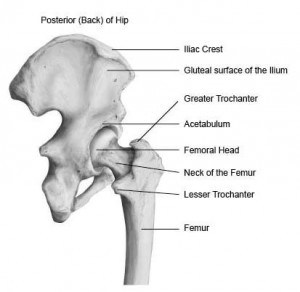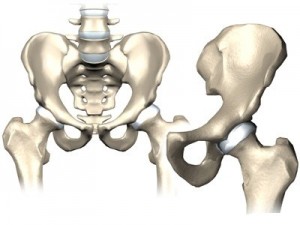IT Band Syndrome, Bursitis, Piriformis Syndrome, Hip Flexor Tendonitis, Labral Tears
ANATOMY:
The hip joint is a ball and socket joint between the head of the femur and the acetabulum of the pelvis. The hips primary function is to support the weight of the body during both static (e.g. standing) and dynamic (e.g. running) activities and holds a very important role in maintaining balance.
The hip joint is one of the primary weight bearing joints in the body, second only to the knee. The high demands that are placed on the hip require it to be a very strong and stable joint. The strength and stability of the hip is increased by the deep socket, strong surrounding ligaments, including the strongest ligament in the body and a complex mixture of 27 different muscles.
COMMON HIP INJURIES:
ILIOTIBIAL BAND SYNDROME (ITBS) and GREATER TROCHANTERIC BURSITIS (GTB): ITBS and GTB are typical overuse conditions frequently affecting individuals that participate in running and bicycling. Both conditions are usually associated with repetitive hip and knee flexion and extension. It is very common to experience both conditions at the same time.
- GTB is an inflammation of the trochanteric bursa. This bursa is found on the greater trochanter of the femur and functions to reduce friction between the muscles, tendons and bones of the hip. Symptoms of GTB can include generalized pain in the hip region, pain with running, going up or down stairs and standing from a seated position, tenderness over the outer hip, and an inability to lie comfortably on the affected side.
- ITBS is an irritation or inflammation of the iliotibial band (ITB). The ITB is like a large rubber band that runs from the outside of the hip to the outside of the knee and holds an important role in stabilizing the knee during activities, especially running. Symptoms of ITBS may include achiness, pain or a stinging sensation that is typically found over the outer aspect of the hip, knee or both. The onset of this pain usually occurs toward the middle or end of running, bicycling or other activities. However, it is not unusual for the pain or achiness to continue for some time after completion of the exercise.
PIRIFORMIS SYNDROME: Piriformis syndrome occurs when the piriformis muscle shortens or spasms due to trauma or overuse causing pain centralized in the buttock area. Sometimes the piriformis muscle can cause compression or irritation of the sciatic nerve. When the sciatic nerve is involved, it can cause pain, tingling and numbness in the buttocks and down the lower thigh and even into the leg.
ILIOPSOAS TENDONITIS: Iliopsoas tendonitis is an inflammation of the iliopsoas tendon and is also known as hip flexor tendonitis. This tendon runs over the front of the hip and can become inflamed after an injury or with overuse. As the inflamed tendon rubs over the bone of the hip socket, it can catch, causing a painful click or snap, which can be felt and/or heard. Because the iliopsoas muscle acts as a hip flexor, symptoms are often worse when bending the hip, especially against resistance. Unlike the hip joint itself, the iliopsoas tendon is fairly close to the skin, so the front of the hip area or groin may also be tender to the touch.
LABRAL TEAR: The labrum is a layer of cartilage that forms a ring and surrounds the socket of the hip joint. It helps provide stability and flexibility to the joint. There are two types of labral tears, traumatic tears caused by sports related injuries or falls and degenerative tears that are a chronic injury caused by repetitive use and activities. A hip labral tear can be difficult to diagnose. Many of the symptoms are similar to the those of a groin strain or other athletic injuries and can include groin pain, limited range of motion, and clicking or snapping of the hip.
TREATMENT:
- Treatment is patient specific depending on the extent and type of injury.
- Treatment should minimize pain, increase strength and range of motion, and return patients to pre-injury status.
- Treatment may include:
- Stabilization exercises to strengthen weak muscles
- Manual techniques such as massage and stretching to assist with increasing flexibility and range of motion
- Electrical stimulation to decrease pain and swelling
- Ultrasound to heat tissues, muscles and tendons that are deep inside
- Superficial heat or ice to assist with pain control
- Surgery is the last resort, but is sometimes necessary if traditional physical therapy treatment is not providing desired results.





Recent Comments